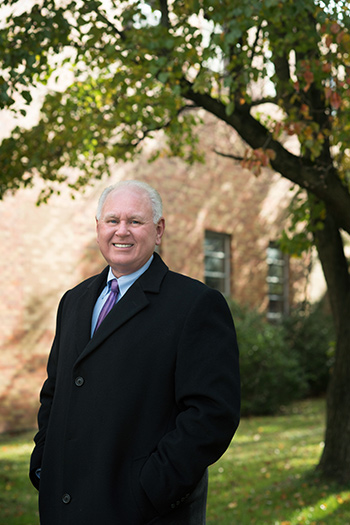Managing clients’ now, later, & never money
Managing clients’ now, later, & never money

Randy Kerns CIC, ChFC • Bridgeport, WV
United Security Agency • Voya Financial Advisors, Inc.
Randy Kerns believes asset protection is equally as important as asset growth for client portfolios, no matter what “bucket” the money falls into. Clients have money they need for current expenses, money they need to properly manage and grow for intermediate needs, and money they might never plan to touch to ensure an income stream through retirement.
Proactive Advisor Magazine: How do you differentiate your practice, Randy?
Our business is probably a little different than the normal advisory practice as we have several different business entities under our overall umbrella. I started a property and casualty agency from scratch in 1981 and have grown that business ever since through several acquisitions. From starting at zero with our first policyholder, we now do about $40 million a year in premium as of the end of 2014.
In the latter part of the 1980s, the trend for major insurance and financial-services companies was toward building out an array of services that could be combined to serve multiple financial needs of both commercial and individual clients. I thought turnabout was fair play, and I decided to get my securities licenses and start our advisory practice. The rest is history, and we have been very successful at both sides of the business.

Are there synergies between P&C and the investment side?
Certainly. We have several major commercial clients who have engaged us to handle all of their P&C needs, to institute their company’s 401(k) plan, and to serve the personal financial-planning needs of key principals. To a much lesser degree, we will manage both personal and advisory needs for individual clients. That has been very rewarding, as risk mitigation is valuable for individual clients across all areas of their financial lives. One focus going forward is trying to build an even stronger bridge between the two major sides of our parent company—people have far greater exposure in their lives than just their investment risk.
What is your overall philosophy toward investments in the advisory practice?
It all starts with the planning process and becoming a client’s trusted consultant. It is a deep responsibility to help individuals and families to plan for their financial future, and I take that very seriously. But at the same time, it is a two-way street, and the ideal client is open to education and in working with me to understand some core concepts, especially around risk management for their investments. The vast bulk of people are incredible in that regard—it is enjoyable meeting and working with them, and they are very open to becoming better educated about their investments.
“I tend to prefer a combination of strategic and tactical strategies within a client’s overall portfolio so that a number of risk-managed approaches can be employed at the same time.”
What are some of those core concepts?
After we have the basics squared away and a thorough understanding of their financial picture, I develop broad recommendations on asset allocation, what some might call the “bucket planning” approach. I like to put that in colloquial terms for clients and call it their “now, later, and never money.” They have money they will need right now for expenses whether they are in retirement or not. They have money they will need to properly manage and grow to help fund intermediate expenses. And they should have a portion of their assets that they should never plan to touch to ensure they can have an income stream throughout a lengthy retirement.
The key to the latter two areas is both growth and protection of assets. I made a major change several years ago from being involved as a transactional trader of client accounts to using managed money platforms. It was also a transition from traditional passive asset-allocation models to more modern active money management. In terms of the client, it is important that they understand my job is not to manage their investments directly, but to engage in finding the best third-party investment managers I can and to meet their individual planning needs. This might involve using a manager with a focus on a pretty specific investment strategy that he or she executes extremely well or using managers who combine multiple risk-managed strategies.
I look at a variety of different asset-modeling approaches, depending on client needs. I tend to prefer a combination of strategic and tactical strategies within a client’s overall portfolio so that a number of risk-managed approaches can be employed at the same time. One of our third-party managers does an excellent job of spreading risk by using multiple asset classes in a broad portfolio approach. There can also be highly tactical elements incorporated within this, so the client is really seeing risk management practiced for their account on multiple fronts.
Does this match up well with client attitudes and concerns you typically encounter?
 It does. I remember back to the dot-com and 9/11 era when clients were getting crushed in their equity accounts. It made for some very long nights of worry and troubling phone calls with clients. While there are no ultimate guarantees with any investment, that kind of deep client loss can be potentially mitigated by using third-party active managers. It is my opinion that my clients fared well through 2008-2009 due in part to the strategies we employed. Our use of products and strategies has evolved through time and experience to include a broad use of active management for many more client accounts.
It does. I remember back to the dot-com and 9/11 era when clients were getting crushed in their equity accounts. It made for some very long nights of worry and troubling phone calls with clients. While there are no ultimate guarantees with any investment, that kind of deep client loss can be potentially mitigated by using third-party active managers. It is my opinion that my clients fared well through 2008-2009 due in part to the strategies we employed. Our use of products and strategies has evolved through time and experience to include a broad use of active management for many more client accounts.
I tell clients that it is important to take advantage of equity markets in a strategic way when the wind is blowing favorably and behind your sails. But it is equally important to batten down the hatches with tactical techniques when storm clouds approach. Buy-and-hold investing does not allow you to do that—active management does. Active management can also allow for the use of leverage when markets are really performing well, or inverse strategies when markets start trending down.
I explain to clients that in the sophisticated investment world we live in, they may find that they are much better off having professionals with active investment management as their exclusive focus minding their portfolios. These managers have the time, knowledge, and sophisticated models to help stay on top of trends in the market and to anticipate changes, such as shifts in the interest-rate environment that we will definitely be seeing. Their strategies can include multiple asset classes, be strategic or tactical, and employ risk management to help control drawdowns and defend portfolios when risk events hit the market hard. This more modern approach is something my clients are very receptive to, once I explain the philosophy.
How would you characterize your relationships with advisory clients?
Empathetic, proactive, and upbeat. I show clients how they can effectively plan for their future, rather than worry about possible shortfalls in their prior planning. That usually requires a strong dose of client education. And it also requires clients who are willing to embrace new ways of thinking about investments and managing the risks that can impact all portfolios.
Disclosure: Securities and investment advisory services offered through Voya Financial Advisors Inc. (member SIPC). United Security Agency is not a subsidiary of nor controlled by Voya Financial Advisors, Inc. 21423006_IAR_1215
Photography by Martha Rial

